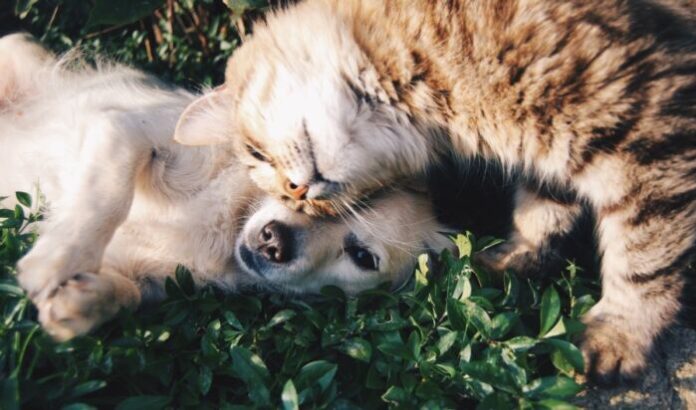
Here we are. The heat has arrived and, to make sure we don’t find ourselves unprepared, the National Animal Protection Agency reminds you of the small precautions to be taken to enjoy the summer with our animals. Dogs and cats, in fact, do not sweat like us and, to lower their body temperature (already normally around 38.5 °), respiratory rates increase. Furthermore, just like us, they are subject to sunburn. Unfortunately, every summer too many dogs still suffer from heat stroke, in particular to brachycephalic breeds, that is, with a short and wide head like the bulldog. So how do you adjust to prevent? How to recognize a heat stroke and how should we behave in the case?
HOW TO RECOGNIZE A STROKE OF HEAT: The skin burns, the animal staggers and breathes quickly and quickly, it seems as if it is blocked. The heat stroke occurs with depression, hyperthermia (high fever), congestion of the mucous membranes (which can take on an intense red color) up to the convulsive seizures and the coma of the animal.
HOW TO BEHAVE: The first thing to do is move it from the sun and lower its body temperature by wetting it with water with a cloth or with your hands, without immersing it, on the whole body and especially on the neck, under the head and on the abdomen . Never immerse the dog in water because it could have lethal side effects. The wisest intervention after these actions is in any case to bring the animal as soon as possible to an equipped veterinary center where it will be possible to carry out all the checks and therapies that can only be carried out in a clinic and that can save the life of the animal.
PREVENTION FIRST OF ALL. Here are some tips that can be useful for living the summer safely with our animals:
1) Avoid walking in the warm hours. Make sure that our animals always have fresh water, a shady and ventilated place and reduce sports activities.
2) Remember that the asphalt is hot and could burn your paws. How to regulate? If it is too hot for our feet it will also be for the sensitive fingertips of our four-legged friends. So beware of city walks.
3) Make sure that our four legs always has fresh water available in his bowl and, if we go out with him, we carry a bottle of water with him to make him drink.
4) We never leave our animal in the car, it risks dying! In fact, the temperature inside the passenger compartment rises rapidly, even with the windows open, and can reach up to 70 °. Forgetting or leaving your four-legged friend in the car means condemning him to death. If you notice a closed animal inside a car: pay attention to the symptoms of a heat stroke (breathing problems, general tiredness). In these cases, immediate intervention can save his life: if the owner of the car cannot be traced, immediately call the police. Until they arrive, it is necessary to try to create shade by arranging for example some newspapers on the windshield and, in case the windows should not be completely closed, pour water inside to wet the animal or make it drink. In extreme cases, citizens have broken the car window to rescue the four-legged and avoid certain death. In these circumstances, the Enpa, considering the safety of the animal prevalent, offers its legal support.
5) Even pets are subject to sunburn. You can protect them by applying a high protection sunscreen to the white ends and the tips of the ears before letting them out. Particular attention to white animals, they are the most subject to sunburn.
6) Attention to food and residues in bowls. Choose light, easy-to-digest foods and never leave food residues in the bowl.
7) For the little fishes: the Enpa reminds that forcing these animals to live in an aquarium means inflicting unnecessary suffering on them. However, anyone who owns an aquarium should not expose it to direct sunlight. It is also important to change the water regularly taking care to remove the algae that form. Whoever had a garden pond must fill it regularly to compensate for the water that evaporates and thus replace the lost oxygen. The same goes for canaries and hamsters who should not be forced into captivity and who, however, should never be left on the balcony in direct sunlight; the cages should be placed in a cool, airy and shaded place.
8) Beware of pests. Better to apply a pesticide suitable for the species and size in advance: some products for dogs can be lethal to cats. It is essential for dogs to prevent phlebotome bites (they are similar to mosquitoes) that can transmit leishmaniasis. There are also commercially available preparations based on Neem oil, a powerful disinfectant and pesticide, which does not present any contraindication even for the most sensitive subjects.
9) Parasite alarm also for rabbits and guinea pigs. In this case it is necessary to carefully inspect the animal every day to check for flies’ eggs on the fur (they also infest dogs), keep the place where they live clean and change the litter or the bottom at least two days a week .10) For wild animals, leave a small bowl of water, not deep, remembering to change it at least once a day; in this period wildlife has a lot of food available while water could be a problem. Who has balconies and terraces can create small shaded areas with plants.






































